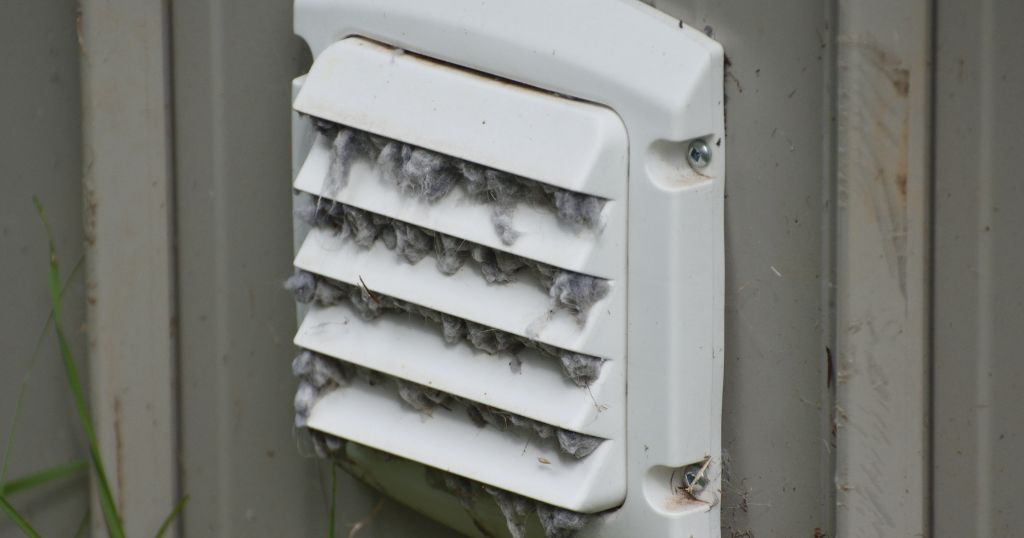Symptoms of Clogged Dryer Vent
Symptoms of Clogged Dryer Vent
A clogged dryer vent can lead to fire, causing property damage worth millions of dollars. Fires that erupted due to the lack of maintenance on dryers have made many people lose their dream homes and the things that were too close to their hearts. That’s why knowing the symptoms of a clogged dryer vent and scheduling dryer vent cleaning on time is necessary.
Over time, lint and other dust particles might accumulate in the dryer vent and exhaust system, creating a highly flammable environment. When people operate clothes dryers with an accumulation of such elements in the vents, a fire ignites and causes a lot of damage to property.
If you don’t want such things to happen to you or any of your loved ones, prioritize dryer vent cleaning. But most people don’t even know when to get their dryer vent cleaned, or some can’t even figure out if their dryer vent is clogged. The signs of a clogged dryer vent include extended drying times, overheating of the equipment, a burning smell when the dryer is in operation, and more.
Keep reading our exclusive blog to learn more about clogged dryer vent symptoms and protect yourself and your loved ones from potential mishaps.
Signs of Clogged Clothes Dryer Vent

A home fire is a situation that nobody wants to be in, as it can severely damage property or even the occupants. To ensure you never face such a situation, you should get your dryer vents cleaned at the right time. Here are the clogged dryer vent symptoms you should never ignore:
Extended Drying Times
Neglecting the maintenance of dryer vents can lead to a lot of issues, with extended drying times being one of the first symptoms of clogged dryer vents and that something is amiss. If your clothes dryer is taking an unexpectedly long time to dry your clothes, you need to check your dryer vents; they might be clogged.
As your clothes dryer diligently works to remove moisture from clothes, lint, and debris accumulate in the vent over time. This buildup acts as a barrier, impeding the smooth flow of hot, moist air generated during the drying process. The result is a restricted airflow that forces your dryer to work harder and longer to achieve the desired dryness.
Extended drying times contribute to increased energy consumption, reflecting on your monthly utility bills. The inefficiency caused by a clogged vent leads to higher operating costs for your dryer. The longer the drying cycle, the more electricity or gas your dryer needs, leading to unnecessary expenses and a larger environmental footprint.
If you find yourself restarting cycles or noticing that clothes are still damp after a full run, it’s time to investigate and unclog the dryer vent promptly if it’s clogged. Regular dryer vent cleaning can restore optimal airflow, improve efficiency, and reduce drying times and energy consumption.
Overheating of Clothes Dryer
Overheating is one of the symptoms of a clogged dryer vent that needs to be addressed quickly. Your dryer works by producing heat to evaporate moisture from your clothes, and when the vent is clogged, this process is disrupted. As lint and debris accumulate in the vent, they restrict the airflow needed to effectively expel hot air from the dryer.
This restriction forces the equipment to work harder to maintain the desired temperature, leading to overheating. The consequences of overheating extend beyond inconvenience; it poses a significant safety risk, potentially resulting in a dryer fire. The warning signs of overheating may manifest as an intense hot or burning smell during operation, excessive heat around the dryer, or even unusual noises.
Ignoring these signs puts both your equipment and your home at risk. Addressing the issue involves regular dryer vent cleaning. By ensuring proper airflow, you not only prevent overheating but also enhance the overall safety and efficiency of your dryer. Don’t wait for warning signs to escalate; proactive maintenance is the key to a safer and more reliable laundry experience.
Increased Laundry Room Temperature

Another symptom of a clogged dryer vent is the unexpected rise in your laundry room’s temperature. It might seem like a minor inconvenience, but it can signal more significant issues within the drying system. When the dryer vent becomes clogged with lint and debris, the hot air generated during the drying process struggles to exit efficiently.
As a result, the excess heat accumulates in the laundry room, causing a noticeable increase in temperature. This not only makes the environment uncomfortable but also indicates potential inefficiencies in the dryer’s performance. The temperature rise is a symptom of a clogged dryer vent causing airflow restriction, and it’s more than just a matter of comfort.
It signifies that your dryer is working harder than necessary, leading to increased energy consumption and potential wear and tear on the equipment. If you notice an increase in your laundry room’s temperature, it’s time to investigate, unclog the dryer vent if possible, or hire a reputable professional for dryer vent cleaning.
Burning Smell During Operation
A burning smell when your clothes dryer is in operation is a symptom of a clogged dryer vent that warrants immediate action. The burning odor typically results from lint and debris accumulating in the dryer vent. As these flammable materials accumulate, they can come into contact with the high temperatures generated during the drying process.
The heat causes them to smolder, producing a distinct burning smell that signals a heightened risk of fire. Ignoring this warning sign can have severe consequences, as it not only poses a threat to the safety of your home but also increases the likelihood of equipment damage.
A burning smell should never be dismissed as a normal part of your dryer’s operation. In case you notice such problems, inspect the dryer vent for visible blockages and promptly unclog the dryer vent if possible. Otherwise, you should consider hiring a professional for a thorough dryer vent cleaning.
Higher Electricity Bills
A spike in electricity bills could be a symptom of a clogged dryer vent. When the dryer vent becomes clogged with lint and debris, the airflow is restricted, forcing your appliance to work harder than usual to provide you with the desired outcomes. All this leads to increased energy consumption and higher electricity bills.
Understanding the connection between neglected dryer vent maintenance and escalating energy expenses is crucial. The longer the drying cycles, the more electricity your dryer requires to operate, contributing to unnecessary financial burdens and a larger environmental footprint.
With regular dryer vent cleaning, you can restore optimal airflow, reducing drying times, and consequently, lowering energy consumption. By addressing the root cause, you not only save on electricity costs but also contributes to a more sustainable and efficient home environment.
Clothes Smell Musty
If your freshly laundered clothes smell musty, it is a symptom of a clogged dryer vent. When a dryer vent is clogged with lint and debris, the moisture-laden air struggles to escape during the drying process. As a result, dampness accumulates, creating an environment conducive to the growth of mold and mildew.
The musty smell that permeates your clothes is a direct consequence of these uninvited guests making a home in your dryer. After recognizing this stale odor, you should consider taking immediate action. Ignoring the issue not only compromises the freshness of your laundry but also poses potential health concerns related to mold exposure.
Dealing with such a problem involves thorough dryer vent cleaning. Either you can go with the DIY approach or consider hiring a professional to unclog dryer vents. By ensuring proper airflow, you not only eliminate the musty smell but also enhance the overall effectiveness of your dryer. A proactive approach to vent maintenance not only preserves the quality of your clothes but also contributes to a healthier and more pleasant laundry experience.
Blocked Vent Hood
A blocked vent hood is a clear symptom of a clogged dryer vent, and you should take action promptly if you see such a thing happening. This can significantly impede the efficiency of your dryer, leading to a range of issues that affect both its performance and safety.
This overlooked component plays a crucial role in expelling hot air and moisture from your dryer, and when obstructed, it can cause many problems. The vent hood, situated on the exterior of your home, is designed to allow the smooth discharge of hot air and moisture generated during the drying process.
When it becomes blocked, usually due to the accumulation of debris, lint, or even external elements like bird nests, it disrupts the airflow. The consequences of a blocked vent hood are noticeable. Extended drying times, increased temperatures within the laundry room, and potential overheating of the dryer are all linked to this issue.
Moreover, a blocked vent hood poses a fire hazard, as the trapped heat can lead to the ignition of accumulated lint. If you notice reduced airflow, lint around the exterior vent, or a burning smell during operation, it’s essential to investigate and address the obstruction promptly.
What’s the Best Way to Clean a Dryer Vent?

After knowing the symptoms of a clogged dryer vent, you might be eager to clean your dryer vents. Indeed, you should clean your clothes dryer vents or get them cleaned by professionals once in a while to maintain the efficiency and safety of the appliance. Here’s the best way to clean out the dryer vent if you plan to do it yourself:
- First, you have to disconnect the dryer from the power source.
- Move the dryer away from the wall.
- Identify and clear the vent exit on the exterior of your home.
- Remove and clean the lint screen or filter inside the dryer.
- Use a vacuum cleaner to thoroughly clean the lint trap, reaching into the trap area.
- Disconnect the vent pipe from the back of the dryer and inspect for lint buildup.
- Use a flexible brush or a dryer vent cleaning kit to clean the entire vent pipe.
- Attach a vacuum cleaner to the vent pipe to remove dislodged lint.
- Go outside, locate the vent hood, and remove any visible debris or obstructions.
- Inspect the vent pipe and connections for damage, then reconnect securely to the dryer.
- Reconnect the dryer to the power source and run a short drying cycle to test for proper airflow.
Establish a routine for cleaning the lint trap after every load and schedule vent system cleaning at least once a year. This will help you keep running your appliance at its peak performance and reduce the risk of fires significantly.
Read more: Benefits of Cleaning Dryer Vents
In Conclusion
The importance of regular dryer vent maintenance cannot be overstated. Neglecting this essential task not only leads to inconveniences such as extended drying times, a musty smell on clothes, and higher electricity bills but also poses significant safety risks, including the potential for a dryer fire.
By following the simple yet effective steps outlined in this guide, you can ensure that your dryer vent remains clear and your appliance operates at its optimal efficiency. From disconnecting the dryer and locating the vent exit to thorough cleaning of the lint trap, vent pipe, and hood, each step contributes to a safer and more effective drying experience.
Remember, a clean dryer vent not only reduces the risk of fire hazards but also extends the lifespan of your appliance and saves on energy costs. Make dryer vent maintenance a routine part of your household chores, and you’ll enjoy not only the convenience of faster drying times but also the peace of mind that comes with a safer and more efficient laundry environment.

 Email Us
Email Us